When and how to re-veg cannabis plants?

Cannabis regeneration (or re-vegging your cannabis plants) is a technique which allows you to regrow your harvested cannabis plant to get a second harvest. It’s a technique often used to preserve ‘keeper’ genetics which you simply don’t want to lose. Re-vegging your cannabis plant isn’t a straightforward process, there are risks and rewards. But if the idea of a second harvest on your finest grow room produce appeals, then read on!
What is cannabis regeneration (cannabis re-veg)?
Most professional and home growers start each of their crops from cannabis seeds or from cuttings. Cannabis is an annual plant, meaning that plants naturally normally last one season and (when male cannabis plants are present) produce a heavy crop of cannabis seeds for subsequent years. However, by manipulating the light cycle after you have harvested your plant you can force the plant to deliver a second (and even a third) harvest.
If you have ever grown cannabis you may be familiar with the feeling of finding a couple of favourite plants amongst those you have grown. Often these ‘keeper’ plants will be particularly special with a golden combination of heavy yields, fast flowering, delicious terpene profiles and banging potency.
If you don’t want to lose these prize cannabis genetics forever you can re-veg your plant. In simple terms that means leaving some green foliage on the plant during harvest (to support photosynthesis) and putting your plants back in your grow room under 20-24 hours of daily light.
After a couple of weeks you will see new vegetative growth appearing, though some of the leaves can look unusual. The traditional leaf shape may be replaced by initially weird looking growth as the plant battles through the process of converting from bloom to new vegetative growth. Here you can keep the plant permanently in vegetative growth as a mother plant if you wish. Or, 1-2 months later you can set your indoor lights to 12/12 light and the plants will begin a second bloom process. This allows you a second harvest from a plant with an already-established root network. Re-veg your cannabis plants well and your second harvest can be even heavier than the first!

Handmade vs accidental cannabis re-veg
Accidental re-vegging can happen if you have e.g. a faulty indoor light timer. If your lights come on for more than 12 hours per day, or if your lights come on unexpectedly during the ‘lights off’ period then your plant can accidentally revert to vegetative growth. You can also accidentally re-veg cannabis if you take your flowering indoor cannabis plants outdoors to finish bloom. If the daylight hours are too long outdoors, your plant will revert to veg growth.
Related:
All you need to know about the cannabis vegetative stage
However, many growers deliberately re-veg their cannabis plants after harvest. Just leave some lower ‘popcorn’ buds and a few leaves on the branches so that the plant can respond to the post-harvest vegetative conditions. Set your light timer for long days and you can watch your plant adapt to re-veg and start putting out new growth of leaves and branches. With an established root network (and the remaining stem, branches etc) your plant is well prepared to be regenerated, and may even have the potential to deliver somewhat heavier yields the second time around.
With an existing root ball and plant framework, a re-vegged cannabis plant can also save you time compared to growing a new plant from cannabis seed.
Related:
All you need to know about the cannabis flowering stage
When should you consider re-vegging cannabis?
If you have grown your plants from autoflowering cannabis seeds then unfortunately it won’t be possible to re-veg your plants. However, if you have grown from photoperiod feminised cannabis seeds then you should find that regenerating your cannabis plant is relatively straight forward. Although most people re-veg female cannabis plants, male cannabis plants can also be regenerated too – though few people outside of the cannabis breeding community would be interested in doing this.

Pros and cons of re-vegging cannabis plants?
Not everyone is interested in the complexity (and possible failures) of attempting to re-veg their cannabis plants. Some growers prefer the satisfying process of germinating their cannabis seeds, nurturing the seedlings and seeing the plant bloom. Re-vegging your cannabis plants can offer some attractive benefits. Unfortunately, this doesn’t come with a 100% guarantee of success. Some strains/plants will respond better than others and it is important to say that regeneration takes time as the plant deals with the challenge of ‘biological hacking’ and is artificially manipulated back into vegetative growth. Here are a few pros and cons to consider.
Pros of re-vegging your cannabis plants
To preserve valuable phenotypes/genetics.
Every so often you will admire your plants as harvest approaches and you will sense that one of your plants is a killer phenotype which is simply too good to lose. Trust your instincts and avoid the regret of losing a keeper, re-vegging your special plant could be the best option.
Avoid the need to keep a mother plant/mother room.
Some serious growers keep a few elite mother plants, but this requires a separate grow room. If you re-veg your best plants you get the benefit of continued bud supply without the hassle of having to keep a separate, dedicated mother room.
Reduced vegetative times.
Although not everyone routinely uses the technique of re-vegging, fans of the technique feel that it can save time for the second harvest. The logic is that the plant already has an existing root network and stem/branches in place, allowing rapid re-growth. However, not all growers are completely convinced that reduced veg times are a major benefit since the re-veg process can take over a month.
The potential for heavier yields.
Partly related to the point above, with an existing root (& branch) framework the weight of the second harvest can exceed the first one. However, this may require a long re-veg period to achieve. Remember that initial regrowth will show leaves with just a single finger. Slowly you will see 3-fingered, then 5-fingered leaves.
It takes time for the normal leaf structure to return. Fans of re-vegging often wait until they get leaves with 7-9 fingers before considering a second bloom. This may take 4-6 weeks. The technique of re-vegging does take time and it can offer the possibility of heavier second harvests but growers should be aware that there are no guarantees.
Save yourself a cannabis seed!
A re-vegged plant will allow you the convenience of a second harvest from one of your favourite plants. This means you can save your cannabis seeds for the future.

Cons of re-vegging (regenerating) your cannabis plants
There are no guarantees of success.
Although many growers re-veg cannabis plants routinely it is a somewhat difficult process for the plant and there are no 100% guarantees that it will work as planned. If it doesn’t, you will have wasted valuable growing time when you could have been germinating fresh cannabis seeds with predictably good results. On the other hand, this pain will be mitigated by the fact that your motives to re-veg were well intended!
Re-vegging cannabis implies plant stress.
There is a certain degree of unnatural logic to the concept of re-vegging. After all, in nature the cannabis plant will have formed seeds and be ready for its life cycle to end. Under human cultivation the plant has been deprived of pollination and then faces the challenge of long daylight hours and revegging.
This stress of this can be seen in the gnarled leaf shapes that can form especially during the early stages of re-vegging. Not all attempts at regenerating cannabis plants are fully successful.
Possible yield compromises if re-vegging doesn’t go well.
If the re-veg process doesn’t go well, subsequent veg growth may be stunted and yields compromised. You can spend a lot of time working with re-vegged plants that just don’t deliver any significant benefits. It’s that risk which tends to put people off from routinely re-vegging their cannabis plants.
Some fans of re-vegging cannabis feel that the technique suits their grow style, but not everyone agrees. Many growers simply prefer to germinate some fresh cannabis seeds for their next crop.
What is monster cropping and why is it used?

Once you have successfully re-vegged your cannabis plant you can keep it as a mother plant and take numerous cuttings from it. Or you could simply re-bloom it. But some growers prefer to avoid regenerating their cannabis plant and instead prefer to try to preserve the genetics by taking cuttings during bloom.
If you take cuttings from a flowering cannabis plant and put the cuttings (clones) into vegetative light conditions it is known as monster cropping. Fans of monster cropping feel that cuttings taken during bloom will grow with greater vigour and heavier yields than would be possible from cuttings taken from a mother plant in vegetative growth.
Monster cropping allows cuttings to be taken from a mother plant without the need for it to be kept in a dedicated ‘mother room’. For some growers, monster cropping is a convenient option though not all growers find it suitable for them (nor are they necessarily convinced about the arguments in favour of monster cropping)
How to re-veg your cannabis plant post harvest?
So you have got that special plant you always dreamed about and it’s nearly ready to harvest. Your early harvest samples blew your mind, the terpene profile teased your taste buds and the XXL yields are everything you dreamed of. Now all you need to do is find a way to preserve the exceptional cannabis genetics and re-veg the plant. Here are the steps you need to follow:
- Take extra care and attention during harvest. Your normal harvest method of chopping each branch off and then hacking the main stem down won’t allow you an optimised re-veg. Instead you need to carefully consider the plant and how it will regrow after harvest. You can help preserve as much of the plant structure as possible with careful harvest pruning. Try to remove buds from the branches without removing the entire branch. Leave plenty of leaves on the plant as well as some of the smaller, lower buds that perhaps you don’t really need to take. These green points will become zones of regrowth in the future. Remember that your plant needs green bud/leaf material in order to photosynthesise.
- Cover the wounds. A small amount of tape is preferred by some growers to cover any gaping holes in branches or the main stem. Though in reality cannabis is a tough plant and can cope even after a severe butchering.
- Flush the root zone. You will be re-vegging your cannabis plant and perhaps offering some nitrogen-rich nutrients for the re-veg. It can help allow the plant a ‘fresh start’ if the root zone is flushed free of any remaining salts/minerals that have accumulated in the root zone. Be sure to treat the roots with care, they are the basis of future nutrition for the second (or third) harvest.
- Possible transplantation to a larger container. If growing in soil you may wish to transplant the plant into a slightly larger container, perhaps with some fresh soil. This can help the plant to adapt to the second growth cycle, though it isn’t absolutely necessary.
- Re-set the light cycle. You will need to set daily light hours to around 20-24 to encourage your plant to revert back to vegetative growth again. Initial re-growth can look tortured and strange but after a couple of weeks you may see the return of normal looking leaves. Remember you won’t need the intense light levels of late bloom, lower power lights will be adequate initially. Once re-veg is established, after 2-3 weeks, you can cut daily light hours back a little further to 18 per day if you prefer. At this stage you can also take cuttings in the normal way and treat your re-vegged cannabis plant as a mother plant if you wish.
- Avoid over feeding and over watering during re-veg. Your re-vegged cannabis plant won’t have the same biomass to support so don’t expect her to need the same amount of water/nutrients as she did in the approach to harvest. If you offer more water (or nutrients) than required during early re-veg you are only making it more difficult for your cannabis plant to adapt to re-veg.
- Start bloom again! You can re-veg as long as you want/need to. Most people tend to allow 4-6 weeks or so. But once you are ready, just set your lights to 12/12 and you can start another bloom cycle. Keep monitoring your plant and feed/water according to your plant requirements in the normal way. When all goes well you can expect a smooth re-bloom and another harvest. Some growers have been known to reveg the same plant 3 or 4 times.
Don’t be afraid to try re-vegging cannabis plants
Cannabis is a tough and flexible plant. If you find a special plant in your grow room that is simply too special to lose, simply consider re-vegging her. Many of the world’s top cannabis growers and breeders do exactly that when they find a rare phenotype!













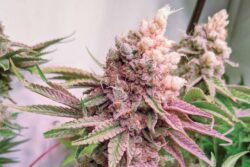

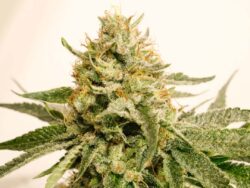
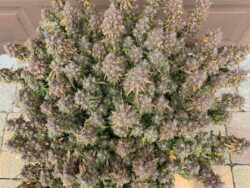
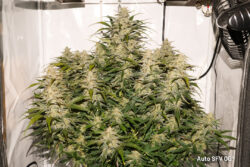
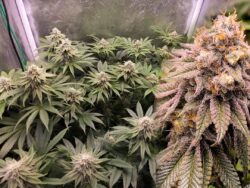

1 Comment. Leave new
I inadvertently left 2 small buds on the bottom of my autoflower white widow. Then ,a few weeks later, I see it is growing leaves on the buds. Lots of leaves…autoflower re-vegging? I hear they wont do that….I will post a pick if possible.